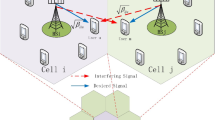Abstract
To avoid the exhaustive search, we propose a fast user selection algorithm for Signal-to-Interference-plus-Noise-Ratio (SINR)-based multiuser Multiple-Input Multiple-Output (MIMO) systems with Alamouti Space-Time Block Code (STBC) transmit scheme. A locally optimal selection criterion is proposed at first. Then, the incremental selection approach is applied, which selects one among the residual available users to maximize the minimum user SINR step by step. Simulation results show that the fast algorithm gains over 90% of the diversity benefit achieved by the exhaustive search selection, and that the fast algorithm has much lower computational burden than the exhaustive search one, for the scenario where the number of all the available users is much greater than that of the selected users.
Similar content being viewed by others
References
E. Telatar. Capacity of multi-antenna Gaussian channels. European Transactions on Telecommunications, 10(1999)6, 585–595.
S. M. Alamouti. A simple transmit diversity technique for wireless communications. IEEE Journal on Select Areas in Communications, 16(1998)8, 1451–1458.
P. W. Wolniansky, G. J. Foschini, G. D. Golden, et al. V-BLAST: an architecture for realizing very high data rates over the rich-scattering wireless channel. International Symposium on Signals, Systems, and Electronics, Pisa, Italy, September 29–October 2, 1998, 295–300.
J. H. Winters, J. Salz, and R. D. Gitlin. The impact of antenna diversity on capacity of wireless communication systems. IEEE Transactions on Communications, 42(1994)2, 1740–1751.
Chen Sun, N.C. Karmakar. Khoon Seong Lim, and Aigang Feng. Combining beamforming with Alamouti scheme for multiuser MIMO communications. Vehicular Technology Conference, Los Angeles, USA, September 26–29, 2004, 1415–1419.
T. Yoo and A. Goldsmith. On the optimality of multiantenna broadcast scheduling using Zero-Forcing beamforming. IEEE Journal on Select Areas in Communications, 24(2006)3, 528–541.
Z. Shen, R. Chen, J. G. Andrews, R. W. Heath Jr., and B. L. Evans. Low complexity user selection algorithms for multiuser MIMO systems with block diagonalization. IEEE Transactions on Signal Processing, 54(2006)9, 3658–3663.
Alireza Bayesteh and Amir K. Khandani. On the user selection for MIMO broadcast channels. IEEE Transactions on Information Theory, 54(2008)3, 1086–1107.
A. Gorokhov. Antenna selection algorithms for MEA transmission systems. IEEE International Conference on Acoustics, Speech, and Signal Processing, Orlando, Florida, USA, May 13–17, 2002, 2857–2860.
M Gharavi-Alkhansari and A. Greshman. Fast antenna subset selection in MIMO systems. IEEE Transactions on Signal Processing, 52(2004)2, 339–347.
Carl D. Meyer. Matrix Analysis and Applied Linear Algebra. Philadelphia, SIAM, 2000, 124, 503, 551.
Author information
Authors and Affiliations
Corresponding author
Additional information
Communication author: Zhang Xiaoge, born in 1975, male, Ph.D. student.
About this article
Cite this article
Zhang, X., Xu, C. User selection for SINR-based uplink multiuser MIMO systems. J. Electron.(China) 26, 492–496 (2009). https://doi.org/10.1007/s11767-008-0074-z
Received:
Revised:
Published:
Issue Date:
DOI: https://doi.org/10.1007/s11767-008-0074-z
Key words
- Multiple-Input Multiple-Output (MIMO)
- User selection
- Signal-to-Interferenceplus-Noise-Ratio (SINR)
- Fast




